Please find attached the most frequently asked questions by professionals, classified by category.
RE2020 regulatory thermal calculation
Carbon
Summer comfort
Energy consumption
Sizing
Degree-hours (DH)
Data sheet for EXHALE ceiling fans in RE2020
RE2020 regulatory thermal calculation
How is the improvement in perceived temperature linked to ceiling fans taken into account in the RE2020?
Air speed is the parameter taken into account when considering the improvement in thermal comfort generated by the fans.
In RE2020, it is calculated on the basis of the following formula: [Air speed] = 0.0032 x [Mixing rate], where:
- [Air speed] = value in m/s
- [Ventilation rate] = [Air flow rate] / [Room volume].
- [Air flow rate] = air flow rate of the air blower in m3/h (the calculation takes into account whether the value is simply declarative, justified or certified).
- [Room volume] = value in m3
Where can I find the calculation method for the RE2020?
All the calculation formulas for air fans can be found here : See the formulas
In RE2020, what is the maximum surface area taken into account for each ceiling fan?
The text states that “the maximum area served by a fan is 15 square metres (m²). Once 15 m² per fan is exceeded, only the fraction of (15 m² x [Number of fans]) is considered to be affected by the ceiling fans.
In RE2020, what is the maximum ceiling height allowed for ceiling fans?
The order specifies that “the model used is valid for ceiling heights of less than 3m”.
How is air speed measured in RE2020?
It is obtained by applying the following formula: [Air speed] = 0.0032 x [Mixing rate], where :
- [Air speed] = value in m/s
- [Ventilation rate] = [Air flow rate] / [Room volume].
- [Air flow rate] = air flow rate of the air blower in m3/h (the calculation takes into account whether the value is simply declarative, justified or certified).
[Room volume] = value in m3
Carbon
What is the carbon footprint of a ceiling fan?
To date, the only Product Environmental Profile (PEP) available is that drawn up by the French Ministry for the Environment, Energy and the Sea. It shows 136 kg of CO2 over the entire life cycle.
Based on this data, plfond fans have seven times less impact in terms of greenhouse gas emissions than a standard electric convector. In the future, it will probably be possible to improve the carbon impact with a more specific analysis.
Summer comfort
Is the contribution of fans in summer over-ventilation taken into account in the RE2020?
No, the benefits of coupling with ceiling fans are not envisaged in the RE2020, and this omission is regrettable. In fact, the effectiveness of night-time over-ventilation for summer comfort has been widely demonstrated, and is taken into account in the regulations.
What is the Givoni diagram, and how does it apply to fans in RE2020?
The Givoni diagram is a graph showing comfort zones, taking into account temperature, humidity and air speed.
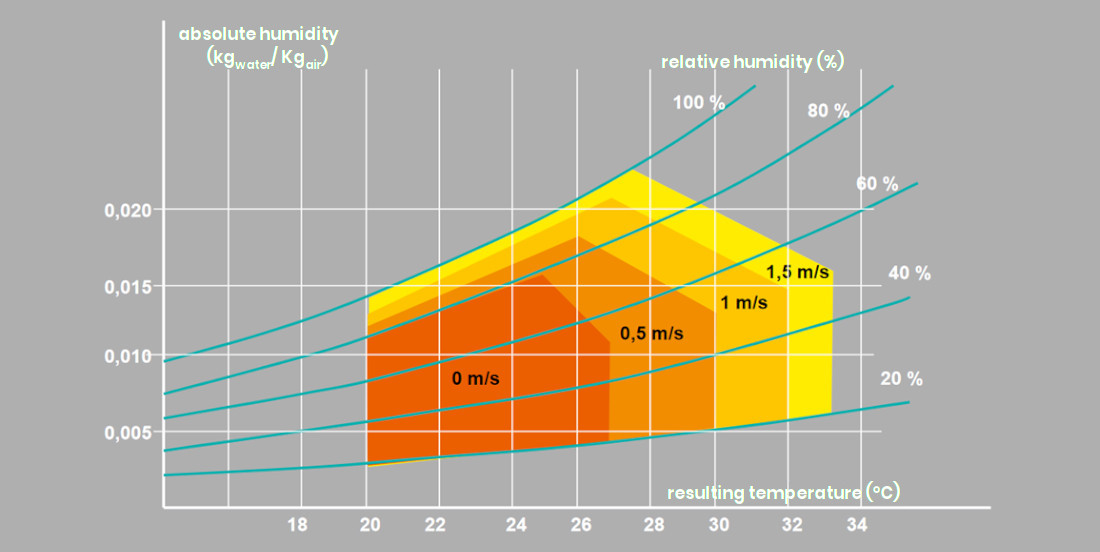
Givoni diagram, Tribe Energy
In the RE2020 calculation, humidity is not taken into account; only air speed has an impact on summer comfort.
Is the winter comfort (destratification) provided by ceiling fans addressed in the RE2020?
Unfortunately not. However, the beneficial impact of winter destratification in terms of both comfort and energy consumption should be included in the regulations.
In a room, warm air is less dense than cold air: warm air rises and cold air stagnates at floor level. The temperature variation can be as much as 1°C per metre of height. This is the phenomenon of stratification.
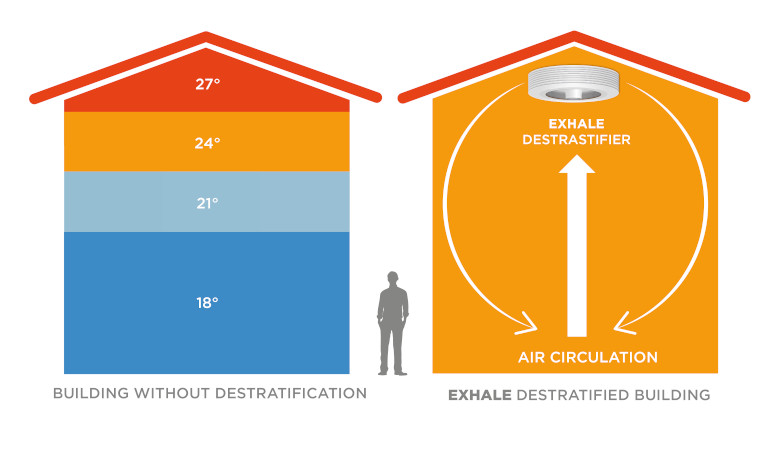
Destratification evens out the temperature between the upper and lower parts of the room.
It has been established that for high-rise commercial and industrial premises, destratification using ceiling fans during the heating season can result in significant energy savings.
This is formalised by two energy saving certificates, one for industry, and the other for the tertiary sector..
Edf (Electricity of France) has also published a study confirming a saving of up to 30% in terms of winter energy consumption.
This type of scheme also works in single-family homes, particularly with cathedral ceilings. The heat is homogenised throughout the room, rather than being concentrated mainly in the ceiling.
What’s more, for de-stratification purposes, a single Exhale fan can even out temperatures over a large volume.
Energy consumption
How much energy can ceiling fans save in RE2020?
The RE2020 will take account of the fan’s own energy consumption. However, the energy gains from fans in air-conditioned buildings have been overlooked.
However, with fans, the cooling season could be shortened. As summer comfort without air conditioning is maintained for longer, it is only during the hottest period that air conditioning would need to be activated. Then, the improvement in thermal comfort associated with the increase in air speed (up to 3°C gain in perceived temperature) would enable the air-conditioning set point to be increased, and consequently the power demand to be reduced.
To back this up, an American study, backed up by numerous field studies, estimates that between 7 and 10% less energy is consumed per degree of air conditioning set point.
Why is the electricity consumption of ceiling fans important in RE2020?
This consumption is taken into account when calculating overall energy consumption. What’s more, the heat generated by the operation of each fan, and therefore its electricity consumption, reduces the temperature gain achieved by the ceiling fans.
That’s why, for a house with several ceiling fans, it’s important to choose energy-efficient units.
Sizing
How do you correctly size and layout ceiling fans in RE2020?
Each ceiling fan has its own specific characteristics. For example, a fan with blades will have an impact mainly at the vertical of its blades, as shown in the diagram below.
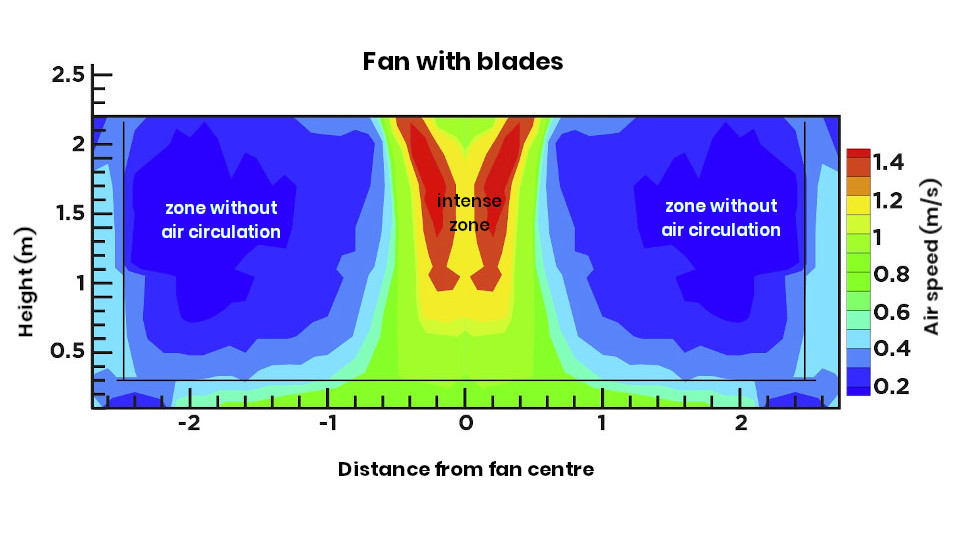
On the other hand, fans without blades will move the air in a room better, but they need to be used in sufficient quantities to be effective.
To help you make the right choices, we have set up a ersonalised support service for professionals, available here. Make the most of it!
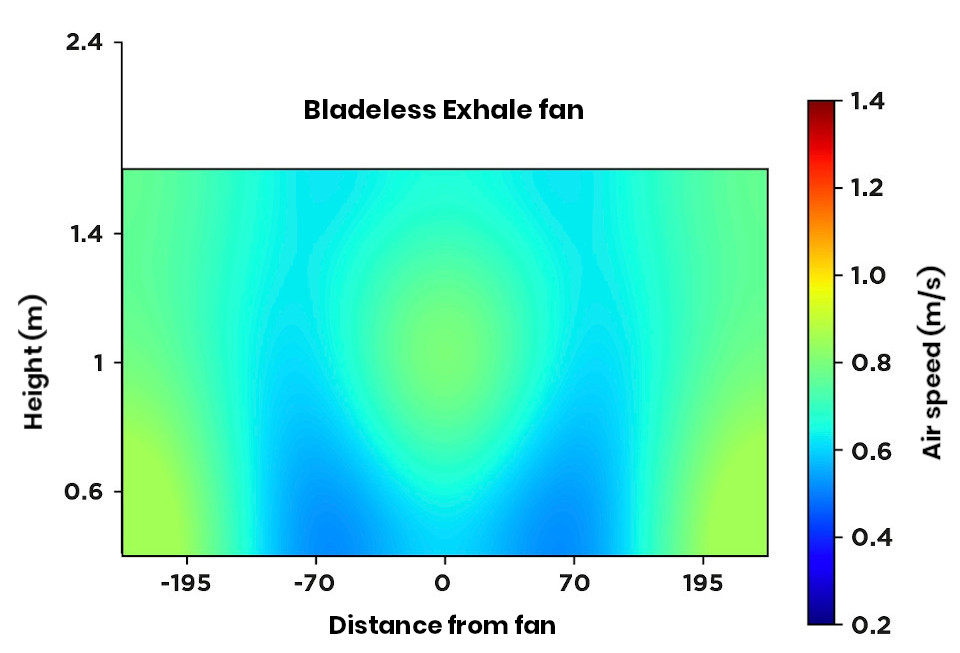
Degree-hours (DH)
Degrees of hours in RE2020: how difficult is it to achieve the target?
This will depend on the climatic zone and the type of dwelling (through-going or not).
It is clear that in the hottest areas, and especially in zone H3 (Mediterranean coast), the use of ceiling fans will often be unavoidable if the objective is to be achieved.
Three renowned consultancies, Bastide Bondoux, Pouget Consultants and Tribu Energie, worked together to publish a study in July 2021 showing the essential role of ceiling fans for summer comfort in RE 2020.
Here are a few extracts:
- “Ceiling fans appear to be a very simple way of drastically reducing discomfort” (p.8).
- “In zone H3, ceiling fans will become the benchmark for limiting discomfort in summer. “The effect of fans on degree hours is always highly valued. They appear to be a very simple way of drastically reducing discomfort, and are even superior to air handling units in zone H3” (p.41).
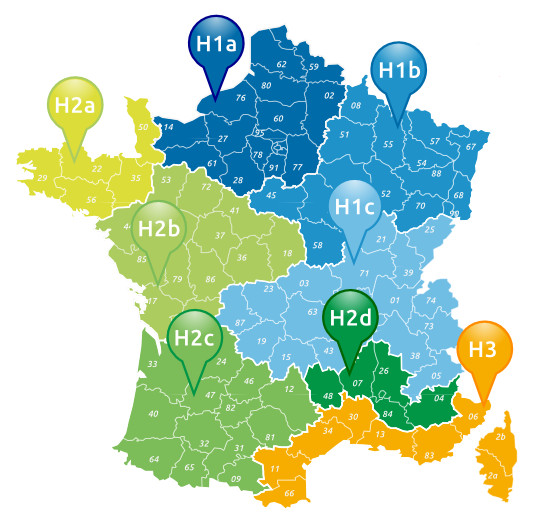
RE2020 EXHALE fan data entry form
How do I enter ceiling fan values in RE2020 software?
We have set up an RE2020 data entry form for the Exhale bladeless fan in our pro area, which can be accessed here: Data entry form
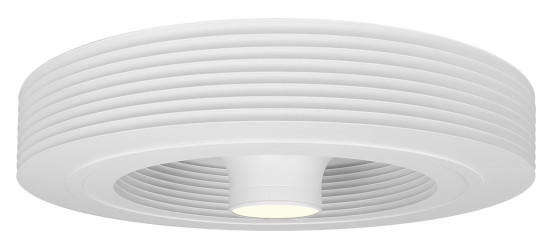
Exhale, the first vortex-effect bladeless ceiling fan
Are you a professional? We have a dedicated area for you.
Find Exhale Fans Europe on Linkedin

